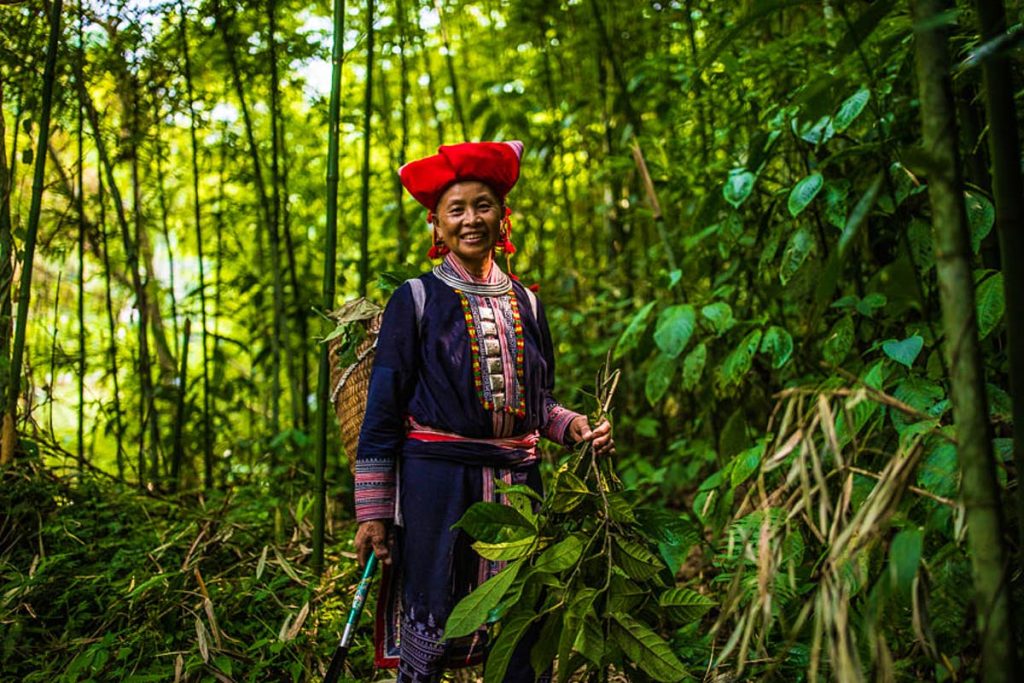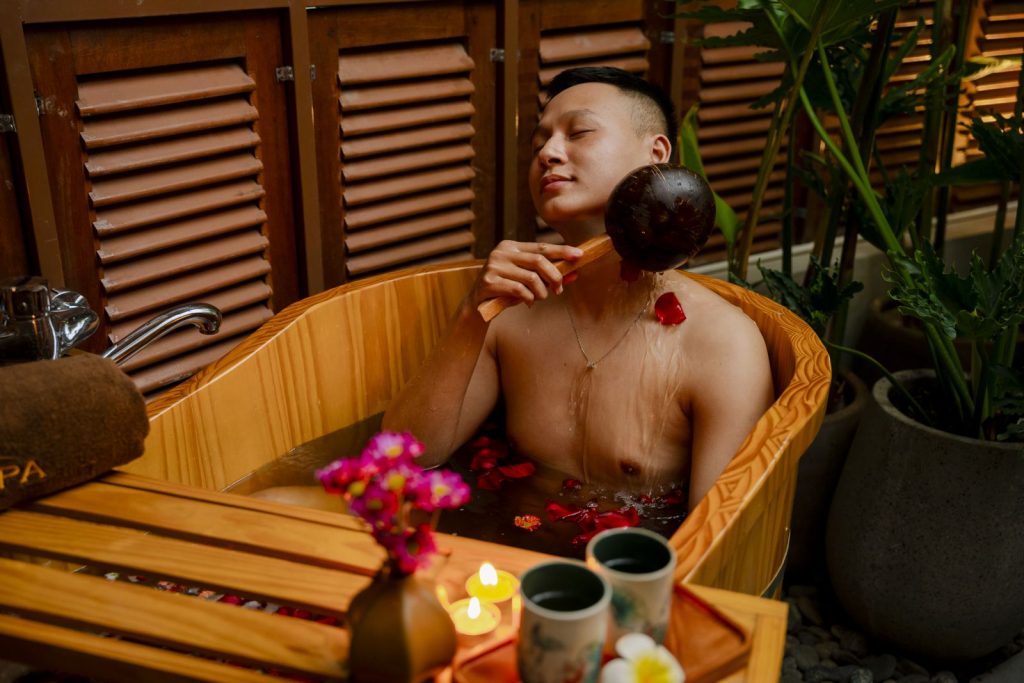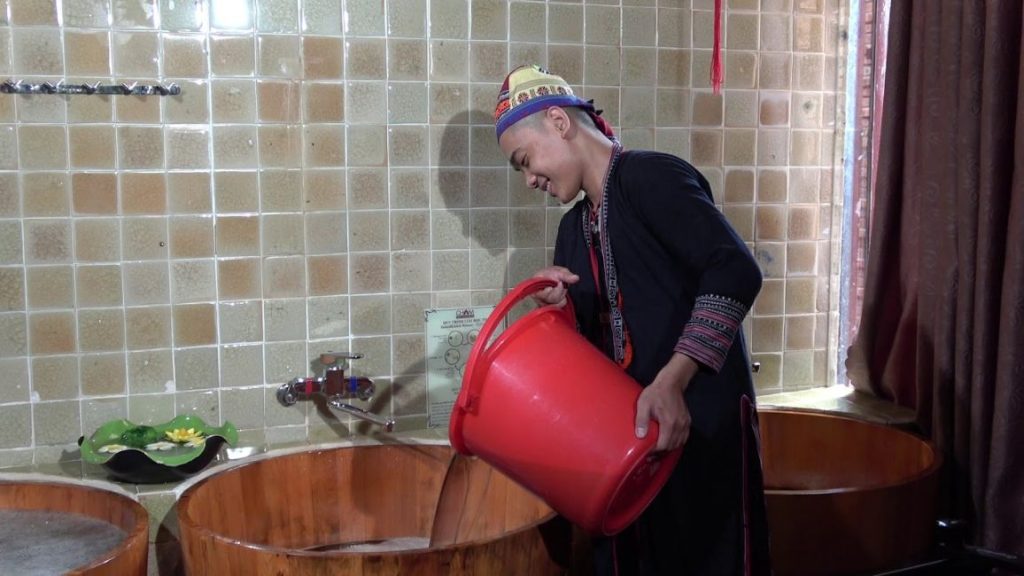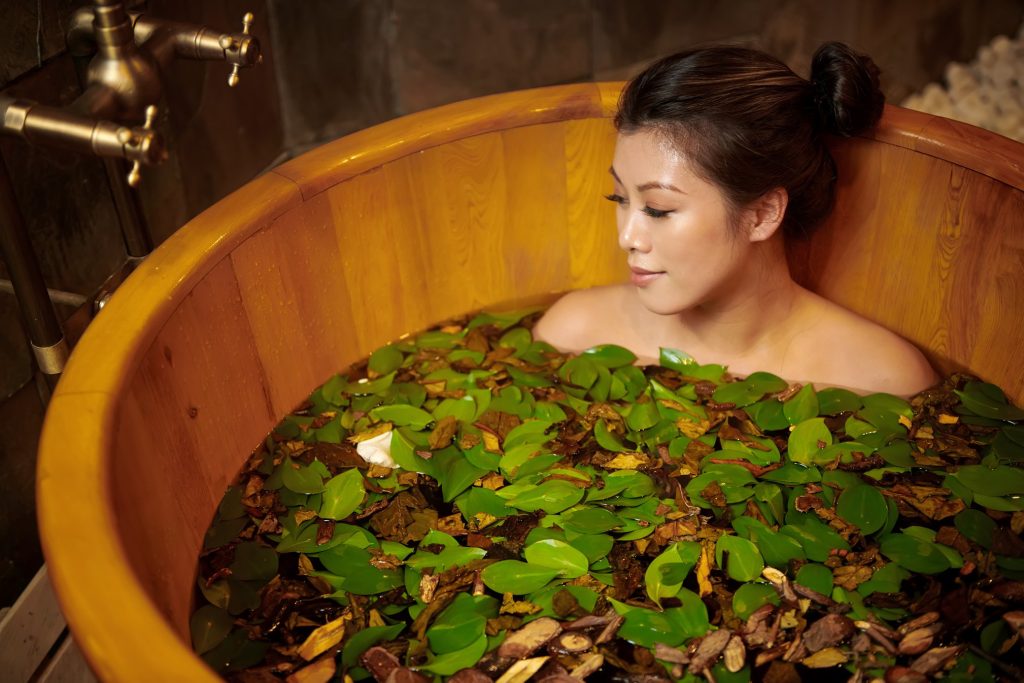The herbal bath of Dao people is a traditional healing practice found in Ha Giang’s highland villages such as Nam Dam, Quan Ba, and Hoang Su Phi. Using over 20 types of native forest herbs, the Red Dao community prepares this warm bath to improve circulation, ease fatigue, and support physical recovery. With Phieu Travel, visitors can join local artisans and experience this time-honored wellness ritual in an authentic, respectful way.
1. Herbal bath of Dao people – A unique wellness ritual in Northern Vietnam
The Red Dao people live in mountainous regions of Ha Giang, especially in Nam Dam, Quan Ba and Hoang Su Phi. Through centuries of living close to the forest, they’ve developed deep expertise in using native herbs for healing. Their knowledge of medicinal plants is not only practiced within the community but is also being studied in wellness programs and cultural preservation projects across northern Vietnam.
Among their most valued traditions is the herbal bath of Dao people – a wellness ritual that blends natural healing with cultural significance. After long hours of farming or in cold seasonal shifts, Red Dao families prepare hot herbal baths to ease muscle aches, boost circulation, and restore energy. This bath is also essential in postpartum care, helping women recover strength and balance after childbirth.
More than just therapy, the Red Dao herbal bath is a symbol of renewal. In the days leading up to Lunar New Year, families collect forest herbs to create a purifying bath that welcomes health and prosperity. Soaking in a hand-carved pomu wood tub filled with warm, fragrant herbal water offers not only relaxation but also a lasting connection to Dao wisdom, nature, and ancestral tradition.

The Ultimate Ha Giang Loop Guide (2025): Itinerary, Map & Tips
2. Top benefits of the herbal bath of Dao people you should know
The herbal bath of Dao people has long been valued by the Red Dao community – not only for its healing properties but also as a way to restore balance between body and spirit. Today, more travelers are drawn to this experience for its holistic approach to wellness. Here are the core benefits that make this traditional practice truly worth trying:
- Supports postpartum recovery: For Red Dao women, the herbal bath of Dao people is essential after childbirth. It helps restore strength, reduce internal heat, and clear toxins – promoting faster recovery both physically and emotionally.
- Relieves muscle and joint pain: Whether from aging, hard labor, or long travel days, the warm bath helps ease stiffness, soothe tired limbs, and improve mobility – naturally and gently.
- Boosts respiratory and immune health: In the cold mountain climate, the bath helps open airways, relieve congestion, and strengthen the body’s defenses against flu, colds, and seasonal illness.
- Reduces stress and improves sleep: The herbal aroma calms the nervous system, helping the mind slow down and the body relax – making it easier to fall into deeper, more restful sleep.
- Stimulates circulation and detoxification: The heat from the bath expands the pores, allowing herbal extracts to penetrate the skin and promote healthy blood flow, while flushing out tension and fatigue.
- Nourishes the skin: Regular bathing softens the skin, reduces irritation and acne, and gives it a healthy glow – often noted by travelers after just one or two sessions.
- Naturally refreshes the body: Beyond its fragrance, the bath helps regulate sweat, reduce odor, and leave the skin feeling light and refreshed.
- Purifies energy and intention: For the Red Dao, bathing is also spiritual. It’s a way to clear away bad luck, illness, or fatigue – especially before the Lunar New Year or after periods of hardship.

3. What’s inside a Red Dao herbal bath? Key ingredients explained
A herbal bath of Dao people blends 10 to over 100 types of forest herbs, selected based on the season and specific healing needs. Many of these plants grow deep in the mountains of Ha Giang and are known only to experienced Red Dao herbalists. Each family guards its own recipe, handed down through generations as part of their living medicinal heritage.
Each ingredient has a purpose. Soothing herbs like Vietnamese mint and elderflower calm the skin, while wild pepper and smilax glabra help ease joint and muscle pain. Warming plants such as lemongrass and cinnamon stimulate circulation and support digestion. Combined, they form a powerful remedy drawn from forest wisdom and ancestral care.
Ha Giang in August: Weather, Things to Do & Travel Tips
4. How the herbal bath of Dao people is prepared traditionally
The process starts with gathering the right combination of forest herbs, depending on the season and health purpose. Only fresh, intact leaves are selected, then washed and lightly stir-heated over low fire for about 20 minutes to release their active compounds.
Next, mountain spring water is added just enough to cover the herbs, then boiled three times to extract their full medicinal value. The resulting liquid is poured into a wooden tub and cooled to around 37 to 40°C – ideal for a 20 to 30-minute soak that helps the body absorb the herbal benefits fully.
Some Phieu Travel routes include early arrival or overnight stays in Nam Dam, allowing guests to witness the full preparation process as part of an extended cultural experience along the Ha Giang Loop.

Ha Giang’s Dao People: A Complete Guide to Their Culture and Festivals
5. Essential tips before experiencing the herbal bath of Dao people
While the herbal bath of Dao people is widely known for its restorative effects, it should be approached with care and respect – especially when used for therapeutic purposes. Here are a few important tips to keep in mind:
- Choose reputable providers: Only use herbal baths offered by trusted spas or Red Dao households with proven knowledge. Avoid unverified or commercialized services with unclear sources of herbs.
- Ask for guidance: Always follow the instructions of the staff or local practitioner. Water temperature, soaking time, and post-bath rest are essential to ensure safety and effectiveness.
- Not recommended during pregnancy: Pregnant women should avoid herbal baths unless advised by a qualified healthcare provider. The active compounds may stimulate the body in unintended ways.
- For therapeutic use, consult carefully: If using the bath as part of treatment for chronic or serious conditions, do not rely on it as a standalone remedy. While the herbs are beneficial, their effects have not been scientifically proven to replace medical care.
After days of winding roads and mountain trails, the herbal bath of Dao people offers the perfect way to restore energy and calm the body. As part of a Phieutravel.com tour, this simple yet powerful ritual becomes a highlight that brings both comfort and cultural depth to your Ha Giang journey.
Read more:
- Top 7 Benefits of the Herbal Bath of Dao People You Must Try in Northern Vietnam
- Ha Giang Lonely Tree: A 250-Year-Old Attraction & Photo Spot
- A Guide to the Ha Giang Golden Rice Season (Sept & Oct)
- La Chi People Vietnam – History, Culture, Traditions & Villages in Ha Giang
- Shan Tuyet Tea: Vietnam’s ancient mountain treasure


You Might Also Like
Ha Giang Weather in September: Complete Guide for Travelers
Exploring the magnificent Ha Giang Loop in September offers travelers a perfect balance of favorable[...]
Quan Ba Twin Mountains: Ha Giang’s Iconic Fairy Hills and Complete Travel Guide
The mystical Quan Ba Twin Mountains rise from the emerald valleys of Ha Giang like[...]
Vuong family mansion: the architectural marvel and cultural legacy of Ha Giang
Deep in Vietnam’s northern highlands, where mist-shrouded mountains meet terraced rice fields, stands a testament[...]
Ha Giang Loop Safety Tips: How to Ride Securely in Vietnam’s Northern Mountains
The Ha Giang Loop, with its winding mountain roads and breathtaking landscapes, offers one of[...]
The Ultimate Guide to the M-Shaped Curve on Ha Giang Loop
Vietnam’s remote northern province of Ha Giang hides a natural wonder that has captivated adventurous[...]
Most Beautiful Places to Visit in Vietnam: Essential Destinations and Insider Tips
Vietnam captivates travelers with its stunning landscapes, rich cultural heritage, and warm hospitality. From mist-shrouded[...]
Beyond the Beaten Path: Discovering Ha Giang Province in Northeast Vietnam
Ha Giang Province in Northeast Vietnam stands as one of the country’s last frontiers for[...]
Rainy season in Ha Giang: what to expect, when to go, and travel tips
Vietnam’s northern frontier reveals a different face during the rainy season, transforming Ha Giang’s limestone[...]